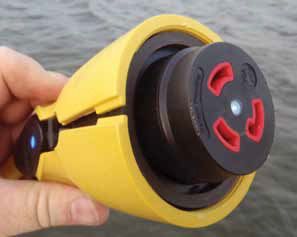
297
We’ve seen a slew of new shorepower cords, plugs, and accessories coming onto the market in recent years, and with good reason. The majority of AC-related onboard electrical fires occur at the vessel’s shorepower inlet. The twist-lock connector used in shorepower cords and at the boat outlet has been around since the 1930s, and the design has seen little updating to make it better suited for use in the marine environment. The electrical contacts are small, exposed to the elements, and often required to support the plug and cord, all factors that beget corrosion and loose connectors, which can lead to electrical arcing, overheating, and fire.
Products like the SmartPlug (PS, June 2010), Marinco’s Galvan-Alert (PS, October 2009), and Prime Technology’s ShIP (PS, May 2009) have all been aimed at improving shorepower systems and making them safer. The latest product to enter the fold is the Easy Electrical Lock (EEL) power cord made by Marinco, a leading maker of shorepower solutions.
The EEL uses the old NMEA-configured contact patterns, which means it is compatible with your old dock outlets, boat inlets, and adapters—unlike the SmartPlug, which uses a unique connector design that isn’t compatible with standard dock outlets. The EEL also did away with the old, frustrating threaded sealing ring and replaced it with a one-handed, spring-activated locking system. The connector, made of BASF Ultramid nylon, has two “wings” that clamp around the threaded base of the boat inlet fitting (the inside of the wings are partially threaded). To connect the plug, squeeze the wings together, push the plug over the inlet, release the wings, and twist the plug to engage the pins.
This jaw-clamp system, along with a gasketed waterproof seal, increases the plug’s water-tightness and means the plug body—rather than the pins—bears the weight and tension of the system, according to the maker. The latter reduces the likelihood that the pins will becomes loose. A secondary lock keeps the wings closed and provides a more secure hookup.
The EEL has three blue LED lights to let users know the cord is energized: one on the outside of each plug and one at the center of the plug’s boat end. The center-plug LED is not to be used for illumination while lining up the plug at night; power should always remain turned off at the dock until the cord is connected at both ends.
The EEL connector is well made, and its cord is similar to the standard Marinco power cords found at most chandleries. Testers found the plug fairly easy to plug in with one hand, as advertised, but its primary installation benefit, in our opinion, is that you don’t have to screw on the retaining ring. However, you do still have to fumble with aligning the pins.
Once clamped in place, the connector is firmly attached. The secondary lock is nice for added security, but the plug was solidly attached even without using it. Testers wiggled and pulled at the connected cord, and it didn’t budge.
Because the connector threads simply clamp onto the inlet threads, you’re not actually matching up the threads or screwing the connector onto the inlet. This is quicker than screwing on a retaining ring.
Available in 30- and 50-amp models, EEL cords are UL approved and come with five-year warranties. There is also a full line of straight, pigtail, and Y-adapters available in the EEL design.
Bottom line
The EEL is an innovative attempt to address problems associated with the traditional twist-lock connector in shorepower systems. While we applaud the EEL’s gains in waterproofing, one-handed operation, and compatibility with existing hardware, the cord strikes us as a mostly cosmetic change that doesn’t resolve the decades-old shorepower cord conundrum.
As Marinco’s response to the SmartPlug, the EEL is certainly a step in the right direction; however, it fails to address some of the SmartPlug’s key advantages, such as larger surface contact area for the pins and thermal protection. That being said, the SmartPlug isn’t without issues: The thermal protection automatically resets after a few minutes (if a plug is over-heating, power should stay off until the problem is fixed), and it lacks UL approval. Neither cord is an ideal solution, in our opinion.
There seems to be no easy fix to the marine AC power dilemma. Marinco is tasked with improving outdated technology, but any re-design is hamstrung by the need to be compatible with its existing systems. The SmartPlug is a better design, but the company is faced with the daunting task of convincing boat owners to upgrade connectors to a system that will only provide half the benefits until marinas decide to upgrade their power pedestals.




































